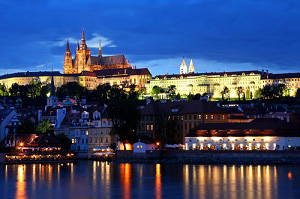
Prague Guide
You will never regret a city break Prague. The Czech capital is full of history in the old town Staré Město and on the Hradčany hill and also has great museums spread through the entire city. We also not yet mentioned great attractions such as the Prague Zoo, the Petrín Hill or what about a boat tour on the Moldau River? Your city break Prague will become even much more interesting if you already know something about the intriguing history of the city. In our online city guide Prague you will get all the information you need, so you will even more enjoy your trip.
History Prague
Around 200 BC a Celtic tribe called Boii settled down at the location where we nowadays find Prague on the banks of the Moldau River. Hundred years later a Germanic tribe conquered the Celtic tribe. In the 6th century this same spot came home to Slavish people of the Moravian Empire. They can be seen as the ancestors of the current Czechs. After the decline of the Moravian Empire the dynasty of the Přemyslids started to rule over the region.
During the first half of the 9th century Duke Bořivoj of the Přemyslids dynasty ordered to build the Prague Castle on the Hradčany hill. Another castle was built during the reign of Boleslav II on the other side of the Moldau River in 972, called the Vyšehrad Castle. In the 9th century also a wooden bridge, the Judith Bridge, was built to connect the two riverbanks. Due to its strategic position more and more German en Jewish merchants came to this place.
Turbulent history of Prague
In 13th century different settlements were connected and formed the Staré Město (Old City). On the other side of the river the Malá Strana was founded (Lesser Town). The Hradčany was founded in the 14th century as an independent borough. The 14th century became very important for the history of Prague. In this period Charles IV was reigning over the region and he was succeeded by his son Wenceslas IV. Both wanted Prague to become the residence of the Holy Roman Empire. Prague thrived and was declared an archbishopric, which lead to the construction of the St. Vitus Cathedral. Charles IV also became the King of Germany in 1346, founded the university of Prague in 1348 and in 1357 he ordered to build the Charles Bridge to replace the collapsed Judith Bridge. In this period Prague was flourishing on an economical as well as a cultural level.
After the dead of Wenceslas in 1419 Prague started to decline and was not as important any more as before and the Hussite or Bohemian Wars began. Different parts of the city were destroyed as well as some important monuments.
Better times arrived in the 16th century under the rule of the Habsbury dynasty with Emperor Rudolf II. Prague again became the centre of Central-Europe. Also the Golden Lane dates back to this period. But the glory days disappeared with his successor Matthias.
The current shape of Prague was gained in 1784 when Josef II joined the Staré Město, Nové Město, Malá Strana and Hradčany together as one city. The Czech language, culture and identity came to life again. Also in the 19th century Prague continued to grow, also due to the Industrial Revolution.
In 1918 Czechoslovakia was declared independent with Prague as the capital of the country. But the independency only lasted till 1939 when the Germans attacked the country. In 1945 Prague was liberated from the Germans by the Soviet army and Prague again became the capital of Czechoslovakia. Three years later in 1948 the Communist Party of Czechoslovakia committed a coup and a long period of oppression followed. Only after the fall of the Berlin Wall and the Velvet Revolution in 1989 the communist regime came to an end. Czechoslovakia was split in two independent countries in 1993, the Czech Republic and Slovakia. The Czech Republic became a parliamentary republic and in 2004 it also became a member state of the European Union.
